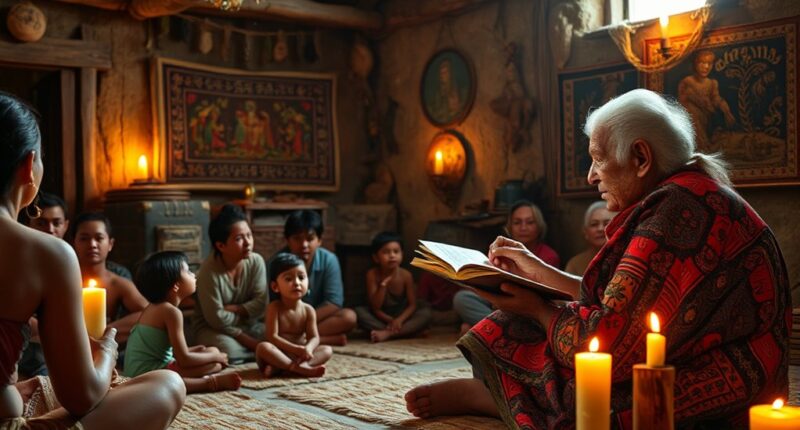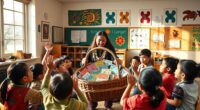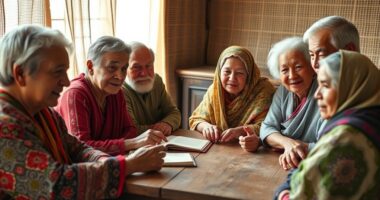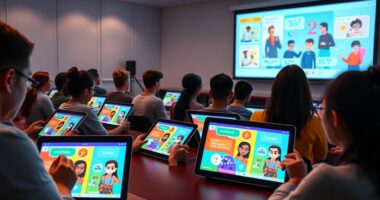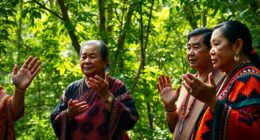Learning through stories is a powerful way to connect with cultural traditions and transfer knowledge. When you hear or tell stories, you engage emotionally, making lessons more memorable. These oral traditions preserve morals, history, and shared values across generations, shaping identity and community bonds. Stories turn complex concepts into relatable narratives, reinforcing understanding and cultural continuity. By exploring more, you’ll discover how storytelling keeps essential knowledge alive and fosters lasting connections.
Key Takeaways
- Oral traditions serve as powerful tools for transmitting cultural knowledge across generations.
- Storytelling makes complex ideas more relatable and memorable, enhancing understanding and retention.
- Participating in storytelling fosters personal connection and active engagement with cultural history.
- Mythology and stories embody societal values, reinforcing morals and cultural identity through oral transmission.
- Continuous storytelling preserves and adapts knowledge, ensuring cultural continuity and societal cohesion.
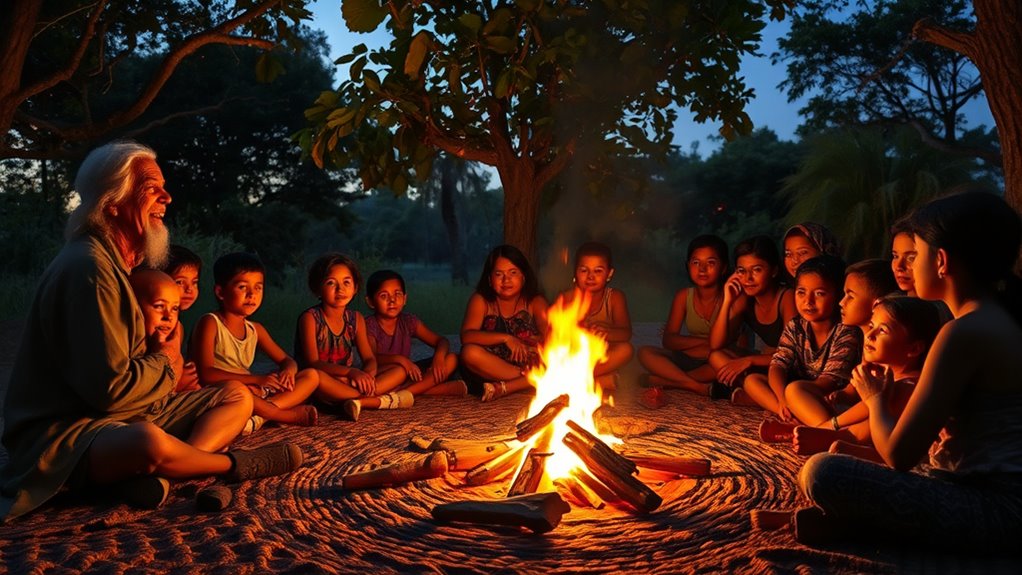
Have you ever noticed how a well-told story can teach you more than just facts? When someone shares a story, especially through mythology storytelling, it goes beyond simple information. It becomes a vessel for cultural transmission, passing down values, beliefs, and traditions from generation to generation. These stories aren’t just entertainment; they’re the threads that weave communities together, creating a shared understanding of the world. As you listen, you’re not only absorbing the narrative but also connecting to the history and identity of a culture. This method of learning is powerful because it engages your emotions and imagination, making the lessons more memorable and meaningful.
Imagine sitting around a fire, hearing ancient myths about gods, heroes, and monsters. These stories are more than tales—they embody the morals and worldview of the society that crafted them. Each myth provides insights into how people understood natural phenomena, human nature, and their place in the universe. Through mythology storytelling, complex ideas become accessible, wrapped in compelling characters and adventures. This form of oral tradition guarantees that essential knowledge isn’t lost over time; instead, it’s preserved in stories that can be retold and adapted, keeping the cultural fabric alive.
Mythical stories embody societal morals, preserving essential knowledge through engaging characters and adventures.
When you participate in this oral transmission, you’re actively engaging with history in a personal way. Rather than reading about a tradition in a book, you’re experiencing it as part of a community’s living memory. This makes the learning process more dynamic and interactive, helping you internalize lessons that might seem abstract if presented as mere facts. For example, a myth explaining the origin of a river or a festival teaches you about the environment and social customs simultaneously, embedding this knowledge deeply within your understanding.
Furthermore, mythology storytelling plays a fundamental role in shaping identity. It provides symbols, stories, and rituals that unite people and reinforce shared values. You learn not just about the stories themselves but about the morals they promote—courage, loyalty, humility, or respect. These lessons are passed down through active listening and retelling, ensuring that cultural principles remain vibrant. By participating in this tradition, you become part of a continuum, contributing to the ongoing process of cultural transmission that sustains societies across generations.
In essence, storytelling is a dynamic way of learning. It transforms abstract concepts into relatable narratives, making knowledge stick. When you embrace mythology storytelling, you’re engaging in a timeless practice that preserves history, reinforces identity, and fosters understanding—proving that stories are some of the most effective tools for learning and cultural transmission.
Frequently Asked Questions
How Do Oral Traditions Adapt to Modern Digital Communication?
You can adapt oral traditions to modern digital communication by embracing digital storytelling, which combines traditional storytelling with multimedia narratives like videos, audio, and images. This approach makes your stories more engaging and accessible to a wider audience. You actively preserve cultural knowledge while innovating with technology, ensuring your oral traditions remain relevant. Using social media, podcasts, and interactive platforms helps you share and transfer this knowledge effectively in today’s digital age.
What Role Do Storytelling Rituals Play in Community Cohesion?
Storytelling rituals strengthen community cohesion by reinforcing cultural identity through mythical symbols and shared narratives. When you participate in these rituals, you connect deeply with others, preserving traditions and values. Mythical symbols embedded in stories serve as powerful icons that unite people, fostering a sense of belonging. These rituals create continuity, ensuring that cultural identity remains vibrant and resilient across generations, deepening bonds within your community.
How Is Storytelling Used to Preserve Endangered Languages?
You use storytelling to preserve endangered languages by passing down traditions and vocabulary through engaging narratives. This strengthens cultural resilience, making the language more relevant and alive within your community. By sharing stories in the endangered language, you actively support language revitalization, ensuring future generations retain their linguistic heritage. Storytelling becomes a powerful tool, connecting communities and safeguarding their cultural identity for years to come.
What Are the Challenges in Documenting Oral Histories?
You face challenges in documenting oral histories because memory preservation can be unreliable, with stories changing over time. Ensuring cultural authenticity is vital, but it’s difficult to capture the true essence without misinterpretation. You might struggle with language barriers, limited recording resources, or the reluctance of elders to share. These obstacles threaten to distort or lose valuable knowledge, making it essential to approach documentation with sensitivity and care.
Can Storytelling Effectively Transmit Complex Scientific Knowledge?
Storytelling can effectively transmit complex scientific knowledge by weaving in mythical explanations that make concepts relatable. You can use mnemonic techniques within stories to enhance memory and understanding. While myths simplify, they also spark curiosity, encouraging listeners to explore scientific details further. By blending myth and science, you engage your audience, making even intricate ideas memorable and accessible through compelling narratives.
Conclusion
You realize that storytelling isn’t just a tradition; it’s the heartbeat of knowledge itself. By sharing stories, you’re passing down wisdom so powerful it could move mountains and change worlds. Oral traditions connect generations, weaving a tapestry of culture that’s richer than any book. Remember, your stories have the power to ignite minds and shape futures—more profound than any other method. Keep telling your stories; they’re the sparks that light the fire of knowledge forever.
Mary is a passionate writer who brings creativity and a fresh perspective to our team. Her words have the power to captivate and inspire, making her an essential contributor to our content. Mary’s commitment to storytelling and dedication to promoting Indigenous culture ensures that her work touches the hearts of our readers. We’re fortunate to have her as part of our team.
